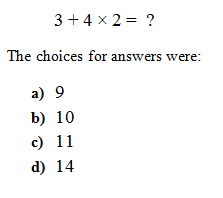 |
| I HATE Math! |
1) Determine why math is your enemy. Did you have a bad experience? Were you ever made to feel stupid, foolish, or brainless? Did your parents say they didn’t like math, and it was a family heredity issue? (One of the curious characteristics about our society is that it is now socially acceptable to take pride in hating mathematics. It’s like wearing a badge of honor or is that dishonor? Who would ever admit to not being able to read or write?) Math is an essential subject and without math, not much is possible...not even telling time!
2) Be optimistic. Suffering from pessimism when thinking of or doing math problems makes it impossible to enjoy math. Come to class ready to learn. At the end of class, write down one thing you learned or thought was fun. I realize math teachers are a big part of how a student views math. In fact, one of the most important factors in a student’s attitude toward mathematics is the teacher and the classroom environment. Just using lecture, discussion, and seat work does not create much interest in mathematics. You've been in that class. Go over the homework; do samples of the new homework; start the new homework. Hands-on activities, songs, visuals, graphic organizers, and connecting math to real life engage students, create forums for discussion, and make math meaningful and useful.
3) Prove Yourself. Take baby steps, but be consistent. Faithfully do the homework and have someone check it. Don’t miss one math class! You can’t learn if you aren't there. Join in the discussions. Think about and write down your questions and share them with your teacher or with the class. Study for an upcoming test by reviewing 15 minutes each night a week before the test. Get help through tutoring, asking your instructor, or becoming a part of a study group. Keep in mind, no one is destined for defeat!
So don’t just sit there and wait for the dreaded Math Attack. Meet it head on with a three step battle plan in hand!
-------------------------------------------------------------------------------
2) Be optimistic. Suffering from pessimism when thinking of or doing math problems makes it impossible to enjoy math. Come to class ready to learn. At the end of class, write down one thing you learned or thought was fun. I realize math teachers are a big part of how a student views math. In fact, one of the most important factors in a student’s attitude toward mathematics is the teacher and the classroom environment. Just using lecture, discussion, and seat work does not create much interest in mathematics. You've been in that class. Go over the homework; do samples of the new homework; start the new homework. Hands-on activities, songs, visuals, graphic organizers, and connecting math to real life engage students, create forums for discussion, and make math meaningful and useful.
-------------------------------------------------------------------------------
 |
| $1.25 |




